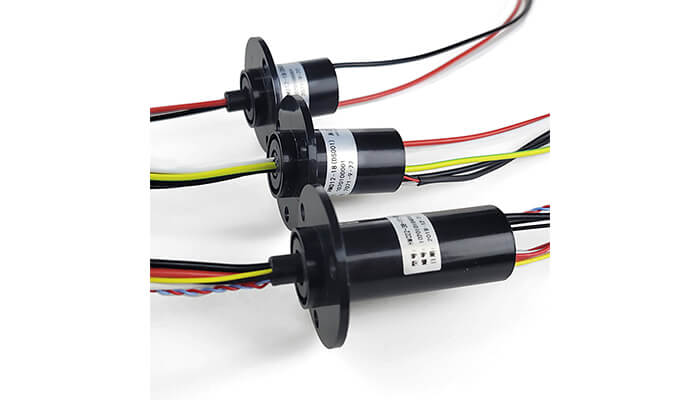Mini slip rings have emerged as an integral component in today’s technological landscape, ensuring seamless and reliable data and power transfer between stationary and rotating parts of various machines and equipment. These compact devices provide a solution for scenarios where limited space is available, making them essential for various applications across different industries.
The importance of mini slip rings cannot be understated, as they cater to the ever-evolving demands of modern industries that prioritize efficiency and space optimization in their systems. Covering vast applications from robotics and medical equipment to aerospace, defense, and consumer electronics, mini slip rings have proven themselves indispensable for enabling smooth and consistent operations.
In this article, we’ll explore the fundamentals of mini slip rings, delve into their underlying mechanics, and examine their various types, applications, and specifications. Additionally, we’ll provide guidelines for selecting, installing, and maintaining these intricate devices while shedding light on future innovations and trends in the field.
What is a Mini Slip Ring?
A slip ring, in its basic form, is an electromechanical device that allows the transmission of power and electrical signals between a stationary and a rotating component. The primary function of a slip ring is to eliminate the need for wires that can get twisted or tangled, enabling a 360-degree unrestricted rotation.
Now, let’s turn our attention to a miniaturized version of this mechanism, termed a mini slip ring. As technology rapidly advances and devices shrink in size, the demand for compact and more space-efficient components increases correspondingly. Mini slip rings respond to this need by offering all the functionalities of a regular slip ring but in a reduced size that typically ranges from a few millimeters to centimeters. Their compactness makes them ideal for applications where size and weight constraints demand small yet efficient solutions.
This adaptation isn’t simply about size reduction; it implies a host of sophisticated design changes and strategic material selections that do not compromise functionality and performance. In the miniaturized versions, the design elements need to be optimized for space efficiency and reduced weight. This includes factors like the size of the rotors and stators, the number of channels, and the contact materials used. Despite these changes, mini slip rings meet the same standards of performance and durability as their larger counterparts, proving their worth even in strenuous operational conditions.
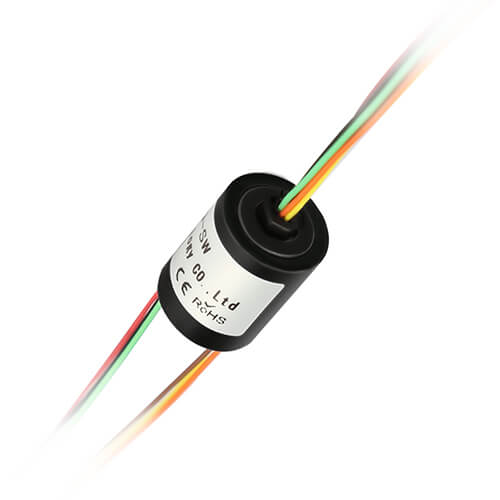
Mini Slip Ring Main Components and Working Principle
Mini slip rings, despite their size reduction, share the same crucial components as their larger counterparts and operate based on the same principle. Below, we will examine the fundamental components and the workings of mini slip rings.
Electrical Contacts
At the core of any slip ring lies the electrical contacts, which are the key to delivering power and transferring data reliably between stationary and rotating parts. Different contact materials can be used, such as gold, silver, or copper, with each offering unique benefits – for example, gold is widely recognized for its low contact resistance and high reliability. The choice of contact material significantly influences the mini slip ring’s performance, as it ultimately affects the signal quality, conductivity, and overall durability of the device.
Rotors and Stators
The mini slip ring assembly consists of two primary parts: the rotor and the stator. The rotor is the part of the slip ring that rotates, whereas the stator remains stationary. These two components create the necessary physical and electrical connection between the rotating and non-rotating elements of the mechanism. As mini slip rings are designed to be space-efficient, their rotors and stators are tightly packed while still preserving the ability to transfer electrical signals effectively.
How Mini Slip Rings Function
The overall operation of a mini slip ring begins with the electrical source being applied to the stationary contacts (on the stator) which then transfer the electrical signals onto the rotating contacts placed on the rotor. The electrical contacts ensure a continuous, low-resistance connection between the stationary and rotating contacts, enabling the smooth transfer of power and data. As the rotor spins, the electrical signals are transferred to the connected rotating components without the hindrance of any tangled or twisted wires.
In summary, mini slip rings primarily function by providing an electrical interface between stationary and rotating systems, while taking up minimal space and maintaining durability and efficiency. Through their electrical contacts and the strategic design of rotors and stators, mini slip rings successfully serve as compact solutions for power and data transfer in various applications where size and weight constraints are crucial.
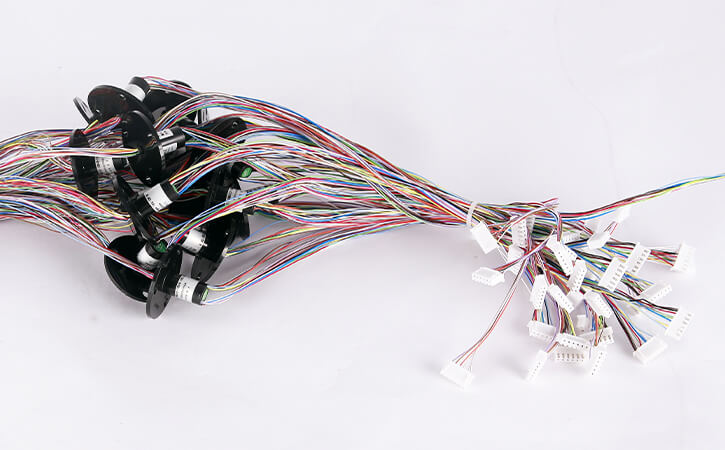
Types of Mini Slip Rings
The versatility and adaptability of mini slip rings are reflected in various available designs, each catering to specific application requirements or system limitations. Some notable types of mini slip rings include capsule slip rings, PCB slip rings, and custom-designed slip rings, which we’ll explore in detail.
Capsule Slip Rings
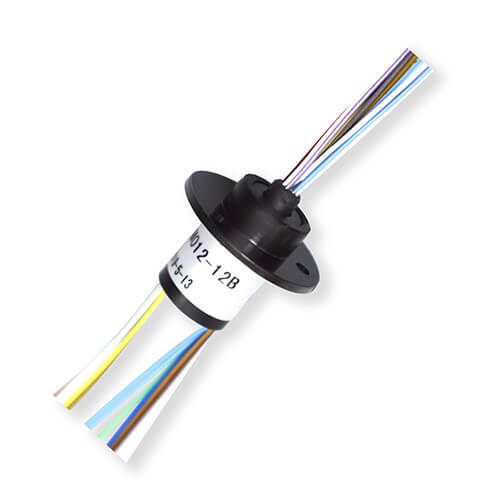
Capsule slip rings, also referred to as miniature slip rings, are an ultra-compact and lightweight option among mini slip rings. They feature a slim, cylindrical shape and compact dimensions, making them suitable for applications where space and weight constraints are critical. This type of mini slip ring has a fully enclosed design, offering protection against dust and debris, and ensuring stability and reliability, even in demanding environments. Typical applications of capsule slip rings include CCTV systems, robotics, medical equipment, and any instance where a compact, efficient solution for data and power transmission is necessary.
PCB Slip Rings
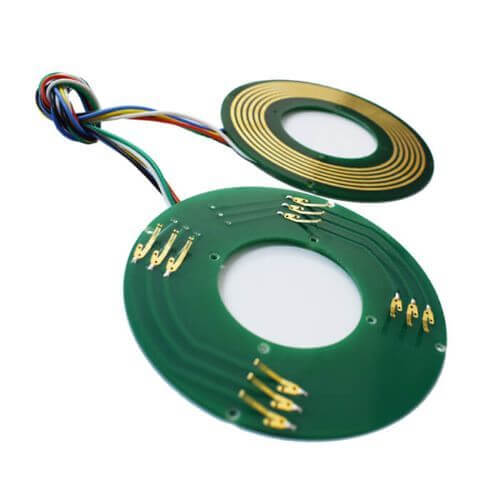
PCB slip rings, also known as pancake slip rings, boast a flat, disc-shaped design, allowing for even more streamlined integration into devices and equipment. Their low-profile configuration provides an optimal solution when vertical space is limited but the available horizontal space can be utilized. These slip rings are directly mounted onto printed circuit boards (PCBs), ensuring seamless and space-saving integration within the system. Applications for PCB slip rings range from rotary tables, antenna systems, and cable reels to other scenarios that demand a thin-profile solution for transferring signals and power.
Custom-Designed Slip Rings
For specific or unconventional applications, custom-designed mini slip rings become necessary to cater to unique requirements and specifications. In these situations, engineers collaborate closely with clients to design and manufacture slip rings tailored precisely to the individual needs of the project. Factors like the size, shape, contact materials, and the number of channels are all considered to ensure an optimal and efficient solution for the given application. Whether it’s a challenging space constraint, unusual transmission requirements, or a particular environmental factor, custom-designed mini slip rings provide flexibility and distinct solutions to accommodate unique project demands.
In conclusion, mini slip rings further demonstrate their versatility and adaptability through the diverse range of available design types. Capsule slip rings, PCB slip rings, and custom-designed slip rings all cater to various applications and environments, allowing for more efficient and streamlined systems. Careful analysis of space constraints, system requirements, and performance expectations will guide the selection of the most appropriate mini slip ring type.

Applications of Mini Slip Rings
Mini slip rings extend their versatile use across an impressive array of sectors, owing to their compact size, efficient performance, and reliable signal transfer capabilities. Here, we will take a look at their applications in several critical fields, including robotics, medical equipment, aerospace and defense, consumer electronics, and surveillance systems.
Robotics
In robotics, mini slip rings play a vital role in facilitating seamless communication and control of robotic parts. These devices enable the transmission of power and signals to the rotating joints of robots without hindering their mobility. Whether it’s industrial robots, humanoid robots, or even surgical robots, the miniaturized slip rings ensure effective data transmission, enhance operational efficiency and contribute to the overall performance and functionality of these robotic systems.
Medical Equipment
The medical field, particularly medical imaging systems like CT scanners, heavily relies on mini slip rings for transmitting power and data. These devices allow the scanner components to rotate continuously and transmit imaging data accurately for further processing and analysis, all while ensuring reliable performance. Mini slip ring’s compact size and high reliability make them ideal for medical equipment where precision and consistency are paramount.
Aerospace and Defense
In the aerospace and defense sectors, mini slip rings are integral to several systems, such as satellites, radar units, and other communication devices. These slip rings perform in extreme operating conditions to facilitate the uninterrupted transfer of power and data signals, playing a critical role in maintaining communication systems and enhancing situational awareness. Their compact size and resilience make them a fitting choice for these demanding applications.

Consumer Electronics
Consumer electronics, particularly ones that involve rotational motion, such as cameras and smart home devices, also benefit from the use of mini slip rings. These components allow for unrestricted 360-degree rotation and continuous power and signal transfer, ensuring smooth operation. Their small footprint and reliable performance make them practically unnoticeable yet indispensable in these electronics.
Surveillance Systems
In surveillance systems, such as CCTV or security cameras, mini slip rings are crucial in providing continuous power and enabling 360-degree rotation of the cameras. They ensure the uninterrupted transmission of video signals for real-time surveillance, contributing to the security and functionality of these systems.
In conclusion, the compact design and reliable functionality of mini slip rings have secured their position in various applications across numerous industries. From intricate robotic systems and high-tech medical equipment to central defense mechanisms, everyday electronics, and security systems, mini slip rings prove to be an essential contributor to technological advancement.
Mini Slip Ring Key Specifications
To gain a better understanding of mini slip rings and their performance, it is crucial to take note of their key specifications. In this section, we’ll discuss the importance of the number of channels/circuits, voltage and current ratings, contact materials, maximum rotational speed, and design customization and versatility.
Number of Channels/Circuits
The number of channels or circuits is a critical specification for mini slip rings, as it indicates the capacity for simultaneous signal or power transfer through the device. This parameter directly impacts the complexity and functionality of the system in which the mini slip ring is integrated. Predominantly, the required number of channels is determined by the specific demands of the application, which could vary significantly.
Voltage and Current Ratings
Voltage and current ratings are essential parameters for mini slip rings, as they denote the device’s ability to handle various levels of electrical power. It is crucial to choose a slip ring with suitable voltage and current ratings for the application to ensure optimal performance and prevent potential damage to the device or the connected equipment. These ratings can also affect the slip ring’s overall size, efficiency, and longevity.
Contact Materials
Contact materials play a pivotal role in mini slip ring performance, as they directly influence the device’s conductivity, resistance, and durability. Common contact materials include gold, silver, and copper, each offering unique benefits. For instance, gold is often used in high-reliability applications due to its low contact resistance and corrosion resistance. Selecting the appropriate contact material is crucial for the mini slip ring’s long-term performance and signal integrity.
Maximum Rotational Speed
The maximum rotational speed indicates the highest permissible velocity at which the mini slip ring can operate effectively while maintaining reliable electrical connections. This parameter is essential for determining whether the slip ring is suitable for a given application, especially high-speed systems. When choosing a mini slip ring, it is crucial to consider the corresponding operational speeds to ensure adequate performance and prevent damage due to excessive rotational velocities.
Design Customization and Versatility
Mini slip rings offer customization and versatility to cater to various applications and adapt to unique project requirements. Design aspects such as size, shape, contact materials, and the number of channels can be tailored to provide the most suitable solution for each scenario. Custom-designed mini slip rings provide flexibility and optimization, allowing for efficient performance in diverse applications and sectors.
To sum up, understanding mini slip ring key specifications – such as the number of channels/circuits, voltage and current ratings, contact materials, maximum rotational speed, and design customization and versatility – is crucial for selecting the most appropriate mini slip ring for a given application. Considering these aspects will enable a well-informed decision, ensuring optimal performance, and maximizing the overall efficiency of the integrated systems.
Mini Slip Ring Installation and Maintenance
Mini slip rings are essential components in various operating systems. To ensure their optimal functionality and longevity, proper installation and maintenance are pivotal steps. This section will guide you through the installation process, routine maintenance and inspection, common troubleshooting strategies, and the approach to replacements and repairs for mini slip rings.
Installation Guidelines and Best Practices
Proper installation of a mini slip ring is a crucial first step to ensure efficient operation and prevent any premature failure. Before installation, it’s important to carefully study the manufacturer’s guidelines on handling, mounting, and wiring the device. Best practices for mini slip ring installation often include ensuring clean and dry conditions, not exceeding specified voltage and current ratings, and ensuring correct alignment.
Refraining from excessive force during installation protects the slip ring from potential mechanical damage. Also, securely fasten both the rotor and stator lead to avoid undue tension on the slip ring during operation. Following these guidelines enhances the performance and extends the lifespan of the device.
Routine Maintenance and Inspection
Regular maintenance and inspection activities are vital for preserving the performance and longevity of mini slip rings. This can involve routine checks for signs of wear or damage, ensuring effective electrical connectivity, and maintaining the cleanliness of the entire assembly. Recommended practices usually involve cleaning the slip rings with dry compressed air and inspecting the general condition frequently for any anomalies.
Troubleshooting Common Issues
Troubleshooting is an integral part of mini slip ring maintenance, as it helps in identifying and resolving common issues that may affect performance. The first step in troubleshooting is recognizing abnormal system behavior, including intermittent signals, increased noise, or loss of data transmission.
When encountering such issues, one should inspect the physical condition of the slip ring, check the mounting alignment, ensure proper electrical connections, and verify compliance of the operation with the device’s specified ratings. If the issues persist, it could be an internal problem with the mini slip ring, necessitating assistance from the manufacturer or trained professionals.
Replacement and Repairs
Like all electromechanical devices, mini slip rings may require repair or replacement after extended usage or in case of significant damage. If critical components like the brushes or contact rings wear out, or if electrical contacts become inconsistent, repairs or replacements may be necessary.
While some simple repairs can be done on-site, complex problems might require professional service or complete replacement. It’s crucial to source replacement parts or services from a reputable provider and ensure that they comply with the manufacturer-specified standards to maintain performance and longevity.
In conclusion, proper mini slip ring installation and maintenance practices are essential to enhance the device’s performance, reduce downtime, and extend its operational lifespan. Adopting best practices during installation, adhering to scheduled maintenance and inspections, effectively troubleshooting common issues, and ensuring suitable and prompt repairs or replacements constitute valuable strategies to ensure efficient and reliable system performance.
Have specific slip ring requirements? Submit your inquiry here.
Selecting the Right Mini Slip Ring
Finding the appropriate mini slip ring for an application entails careful evaluation of numerous factors, ensuring optimal system performance, and maximizing return on investment. This section will guide you through the crucial aspects to consider when selecting the right mini slip ring, including evaluating application requirements, comparing specifications and features, taking supplier selection and customer support into account, and making cost and budget considerations.
Evaluating the Application Requirements
A proper understanding of the application’s requirements is essential before selecting a mini slip ring. Some key factors to consider include the operating environment (e.g., temperature, humidity, chemical exposure), rotational speed, required power and signal transmission types, and the space available for the slip ring.
Each application has its unique challenges and constraints, making it vital to identify the essential performance requirements and select a mini slip ring that best addresses them. For instance, medical equipment demands high-reliability slip rings while aerospace and defense applications often require slip rings capable of withstanding harsh environmental conditions.
Comparing Specifications and Features
After identifying the application requirements, it is crucial to compare the specifications and features of different mini slip rings to find the most suitable one for your needs. Key elements to assess include the number of channels/circuits, voltage and current ratings, maximum rotational speed, contact materials, and compatibility with relevant data protocols or signal types.
Ensure that the mini slip ring is capable of handling the intended load without compromising performance; robust product offerings often feature a balance between size, durability, and power capacity. For applications where high-resolution data transmission is needed, opt for slip rings with low electrical noise and high-quality contact materials.
Supplier Selection and Customer Support
Selecting a reputable supplier is an essential factor when choosing the right mini slip ring. Reputable suppliers often provide high-quality products and offer reliable customer support. During the decision-making process, research different providers, and consider their experience, expertise, product range, and quality certifications.
Check for client testimonials, case studies, and warranty policies to ensure that the supplier can deliver the required level of support. Verify that they provide suitable technical assistance and expertise by discussing specific questions regarding the application and mini slip ring options.
Cost and Budget Considerations
Balancing cost and budget constraints with product quality and performance is a vital aspect of selecting the right mini slip ring. While it may be tempting to choose the most economical product, remember that investing in a higher-quality slip ring often results in better long-term performance and decreased total cost of ownership.
Consider the lifecycle cost, which includes not only the upfront expense but also the costs associated with downtime, maintenance, repairs, or replacements. Opt for a mini slip ring that matches your budget without compromising on quality, reliability, and application-specific requirements.
In conclusion, selecting the right mini slip ring requires careful consideration of various aspects, including application requirements, specification comparisons, supplier selection, and cost and budget factors. By thoroughly evaluating these elements, you can ensure that the chosen mini slip ring meets your needs and contributes to optimal system performance and longevity.
Mini Slip Ring Future Developments and Innovations
The development and innovation in mini slip rings are driven by advances in technology and shifting industry demands. This section discusses trends and predictions regarding future developments and innovations in mini slip rings, considering trends in miniaturization, the use of advanced materials and designs, and emerging applications in new industries.
Trends in Miniaturization
Rapid advancements in technology and the rising demand for compact, higher-performance devices in various sectors underscore the trend toward miniaturization in the slip ring industry. Mini slip rings are becoming even smaller and lighter, with more circuits and increased performance capabilities. This trend is especially prevalent in industries like aerospace and medical technology, where size restriction and weight savings are critical considerations.
In the future, we can anticipate further improvement in mini slip rings – with increased rotational speed capabilities, increased power and signal handling capacities, and an even smaller form factor. The ongoing miniaturization trend also challenges manufacturers to maintain or improve degradational properties, such as resistance to friction and wear, despite reductions in scale.
Advanced Materials and Designs
As the demand for stronger, more durable, and more efficient mini slip rings increases, we’re likely to see more innovation in the use of advanced materials and innovative designs. The industry is exploring new contact materials for higher conductivity and lower resistance, as well as materials that can withstand harsher conditions and increase the device’s lifespan.
Also on the horizon could be enhancements in design – such as placing components in optimal configurations to reduce interference and putting more emphasis on modular designs to meet the diverse needs of various applications. The future may also bring cost-effective production processes that not only boost efficiency but also reduce environmental impact.
Emerging Applications and Industries
Increasingly, mini slip rings are finding new applications in emerging industries. Their role is likely to expand in sectors like renewable energies (wind turbines), robotics (especially in collaborative robots or “cobots”), and autonomous vehicles, all of which require efficient, reliable rotational connectivity solutions.
Additionally, innovations and developments in IoT devices, unmanned aerial vehicles (UAVs), and industrial automation are expected to drive further demand for customizable mini slip rings. As technology continues to advance, new applications that we can’t yet foresee may further broaden the use of mini slip rings.
In conclusion, the future of mini slip rings is poised for continuous development and innovation, driven by trends in miniaturization, advances in materials and design, and applications in newly emerging industries. By focusing on these areas, manufacturers can meet the evolving demands of the market, while users can enjoy enhanced performance and broadened application possibilities.
Conclusion
From their defining characteristics and significant applications to the factors surrounding their selection and prospects, mini slip rings undeniably cement their place as essential components in various technology sectors.
FAQs about Mini Slip Ring
Understanding the intricacies of mini slip rings can often involve navigating through a sea of information. Addressing frequently asked questions can prove beneficial in simplifying complex topics and settling common concerns or misconceptions. This section discusses popular questions about mini slip rings and provides comprehensive answers aimed at enhancing your understanding of these important mechanisms.
Q: What is a mini slip ring?
A: A mini slip ring is a compact electrical component that enables the transfer of power and signals between stationary and rotating parts in a compact and lightweight package. It’s often used in devices where unrestricted, continuous rotation is required.
Q: Can a mini slip ring transfer data?
A: Yes, besides power, mini slip rings are uniquely designed to transfer different types of signals, including data signals. This makes them suitable for applications where both power and data transfer need to take place simultaneously.
Q: How does a mini slip ring operate?
A: A mini slip ring comprises two main parts: a stationary block (stator) and a rotating block (rotor). As the rotor turns, it maintains electrical connections with the stator through a set of sliding contacts. This allows the transfer of power and signals from the stationary component to the moving part and vice versa.
Q: How long do mini slip rings last?
A: The lifespan of a mini slip ring depends on numerous factors, including the operating conditions, the design of the slip ring, and the maintenance practices followed. With proper care and under ideal conditions, mini slip rings can last for several millions of rotations.
Q: Are mini slip rings expensive?
A: The cost of mini slip rings varies depending on factors such as the complexity of the design, the types of materials used, and the specific requirements of the application. While high-quality mini slip rings may have a higher upfront cost, they often provide better performance and longer lifespans, offering more value over time.
Q: Are all mini slip rings the same?
A: No, mini slip rings can vary significantly in their design, size, and performance capabilities. They can be customized to suit specific application requirements, including the number of circuits, the signal types to be transferred, and the environmental conditions.
Q: Can mini slip rings handle high power applications?
A: While mini slip rings are small, they are capable of handling a wide range of power applications. However, the specific current and voltage ratings will depend on the design of the slip ring, and it’s essential to select a slip ring that meets the power requirements of the application.
Want to discuss your slip ring needs? Fill out the form and we’ll reach out to you.


